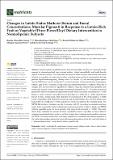Por favor, use este identificador para citar o enlazar a este item:
http://hdl.handle.net/10261/267045COMPARTIR / EXPORTAR:
 SHARE SHARE
 CORE
BASE CORE
BASE
|
|
| Visualizar otros formatos: MARC | Dublin Core | RDF | ORE | MODS | METS | DIDL | DATACITE | |

| Campo DC | Valor | Lengua/Idioma |
|---|---|---|
| dc.contributor.author | Olmedilla-Alonso, Begoña | es_ES |
| dc.contributor.author | Rodríguez-Rodríguez, Elena | es_ES |
| dc.contributor.author | Beltrán de Miguel, Beatriz | es_ES |
| dc.contributor.author | Sánchez-Prieto, Milagros | es_ES |
| dc.contributor.author | Estévez Santiago, Rocío | es_ES |
| dc.date.accessioned | 2022-04-18T10:14:00Z | - |
| dc.date.available | 2022-04-18T10:14:00Z | - |
| dc.date.issued | 2021 | - |
| dc.identifier.citation | Nutrients 13(10): 3614 (2021) | es_ES |
| dc.identifier.uri | http://hdl.handle.net/10261/267045 | - |
| dc.description | This article belongs to the Special Issue Carotenoid Biomarkers of Dietary Exposure and Nutritional Status. | es_ES |
| dc.description.abstract | Lutein is mainly supplied by dietary fruit and vegetables, and they are commonly jointly assessed in observational and interventional studies. Lutein bioavailability and health benefits depend on the food matrix. This study aimed to assess the effect of dietary intervention with lutein-rich fruit or vegetables on lutein status markers, including serum and faecal concentrations (by high pressure liquid chromatography), dietary intake (24 h recalls ×3), and macular pigment optical density (MPOD) and contrast threshold (CT) as visual outcomes. Twenty-nine healthy normolipemic subjects, aged 45–65 y, consumed 1.8 mg lutein/day supplied from fruits (14 subjects, 500 g/day of oranges, kiwi and avocados) or vegetables (15 subjects, 180 g/day of green beans, pumpkin, and sweet corn) for four weeks. Serum lutein concentration increased by 37%. The effect of the food group intervention was statistically significant for serum lutein+zeaxanthin concentration (p = 0.049). Serum α- and β-carotene were influenced by food type (p = 0.008 and p = 0.005, respectively), but not by time. Serum lutein/HDL-cholesterol level increased by 29% (total sample, p = 0.008). Lutein+zeaxanthin/HDL-cholesterol increased, and the intervention time and food group eaten had an effect (p = 0.024 and p = 0.010, respectively) which was higher in the vegetable group. The MPOD did not show variations, nor did it correlate with CT. According to correlation matrixes, serum lutein was mainly related to lutein+zeaxanthin expressed in relation to lipids, and MPOD with the vegetable group. In faecal samples, only lutein levels increased (p = 0.012). This study shows that a relatively low amount of lutein, supplied by fruit or vegetables, can have different responses in correlated status markers, and that a longer intervention period is needed to increase the MPOD. Therefore, further study with larger sample sizes is needed on the different responses in the lutein status markers and on food types and consumption patterns in the diet, and when lutein in a “pharmacological dose” is not taken to reduce a specific risk. | es_ES |
| dc.description.sponsorship | This study was funded by a grant from the Instituto de Salud Carlos III (Ministerio de Ciencia e Innovación, Spain) (grant PI16/01991) and co-funded by the ERDF/European Social Fund. We would also like to acknowledge the support of the Spanish National Research Council (CSIC) (grant P. intramural 201970E033) for the dietary assessment. | es_ES |
| dc.language.iso | eng | es_ES |
| dc.publisher | Multidisciplinary Digital Publishing Institute | es_ES |
| dc.relation.isversionof | Publisher's version | es_ES |
| dc.rights | openAccess | es_ES |
| dc.subject | Lutein | es_ES |
| dc.subject | HDL-cholesterol | es_ES |
| dc.subject | Xanthophylls | es_ES |
| dc.subject | Contrast threshold | es_ES |
| dc.subject | Carotenoids | es_ES |
| dc.subject | Macular pigment | es_ES |
| dc.subject | Human serum | es_ES |
| dc.subject | Intervention study | es_ES |
| dc.subject | Dietary intake | es_ES |
| dc.subject | Faeces | es_ES |
| dc.title | Changes in lutein status markers (serum and faecal concentrations, macular pigment) in response to a lutein-rich fruit or vegetable (three pieces/day) dietary intervention in normolipemic subjects | es_ES |
| dc.type | artículo | es_ES |
| dc.identifier.doi | 10.3390/nu13103614 | - |
| dc.description.peerreviewed | Peer reviewed | es_ES |
| dc.relation.publisherversion | https://doi.org/10.3390/nu13103614 | es_ES |
| dc.identifier.e-issn | 2072-6643 | - |
| dc.rights.license | https://creativecommons.org/licenses/by/4.0/ | es_ES |
| dc.contributor.funder | Ministerio de Ciencia, Innovación y Universidades (España) | es_ES |
| dc.contributor.funder | Instituto de Salud Carlos III | es_ES |
| dc.contributor.funder | Consejo Superior de Investigaciones Científicas (España) | es_ES |
| dc.contributor.funder | European Commission | es_ES |
| dc.relation.csic | Sí | es_ES |
| oprm.item.hasRevision | no ko 0 false | * |
| dc.identifier.funder | http://dx.doi.org/10.13039/501100003339 | es_ES |
| dc.identifier.funder | http://dx.doi.org/10.13039/501100000780 | es_ES |
| dc.identifier.funder | http://dx.doi.org/10.13039/501100004587 | es_ES |
| dc.type.coar | http://purl.org/coar/resource_type/c_6501 | es_ES |
| item.grantfulltext | open | - |
| item.openairetype | artículo | - |
| item.cerifentitytype | Publications | - |
| item.languageiso639-1 | en | - |
| item.fulltext | With Fulltext | - |
| item.openairecristype | http://purl.org/coar/resource_type/c_18cf | - |
| Aparece en las colecciones: | (ICTAN) Artículos | |
Ficheros en este ítem:
| Fichero | Descripción | Tamaño | Formato | |
|---|---|---|---|---|
| changesubject.pdf | 1,25 MB | Adobe PDF |  Visualizar/Abrir |
CORE Recommender
SCOPUSTM
Citations
8
checked on 05-may-2024
WEB OF SCIENCETM
Citations
6
checked on 15-feb-2024
Page view(s)
32
checked on 10-may-2024
Download(s)
35
checked on 10-may-2024
Google ScholarTM
Check
Altmetric
Altmetric
Este item está licenciado bajo una Licencia Creative Commons

